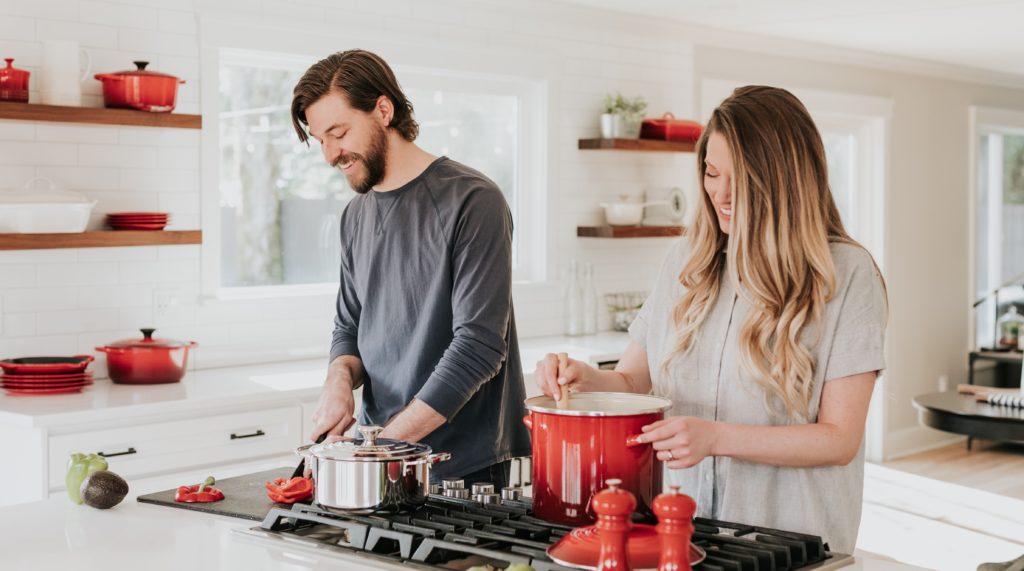
With home cooking on the rise, perishables are increasing in popularity on consumers’ shopping lists
As the pandemic took hold in March and April, consumers scrambled to grab hold of products with long shelf lives as they braced themselves for a sustained period of stay-at-home isolation and feared that out-of-stocks could become an indefinite reality. Genuine worry also set in around where nourishing and well-balanced meals would be coming from with the foodservice channel at a standstill and consumers wary of visiting the grocery store too often due to health and safety concerns. This fear gave birth to a temporary resurgence in demand for meal kit subscriptions that, in recent years, had been dubbed as a fad with high rates of attrition that was on the cusp of becoming a sunset industry.
As the initial panic passed, households began looking for healthy and creative outlets to pass the time and bond the family unit together. Scratch cooking emerged as one such activity, prompting shoppers to scour grocery and convenience stores for scratch baking and cooking ingredients such as flour and eggs instead of the canned goods and toilet paper they were on the hunt for earlier.
The staying power of an uptick in meal kit subscriptions is currently up for debate. As households find themselves with more time on their hands, and in the face of economic uncertainty, they are willing to do the slicing and dicing themselves rather than pay a premium for a meal kit delivery service to do the majority of meal preparation for them. They are also embracing the challenge of discovering and executing meal ideas and recipes themselves over a curated menu that is determined for them by their meal kit subscription provider.
Dining at Home: From Necessity to Ritual
According to Bloomberg, before the pandemic, more than half of Americans’ food budget was spent dining out. As foodservice outlets closed their doors to on-premise dining at the height of the outbreak, consumers were forced to eat more meals at home. As restaurants gradually re-opened, starting with take-out and followed by outside dining and eventually in-door dining at reduced capacity, people were concurrently developing new skills for planning and cooking meals from scratch. Today, while restaurant dining is less restricted in some markets than it was a few months back, households have developed a newfound appreciation for home cooking. They are gravitating to the concept for financial, health and food wastage benefits that have gained importance during the pandemic.
In a survey of over 1,000 consumers conducted from July 14th – 20th by the Food Industry Association (FMI), 22% of those polled indicated that they had improved their cooking skills since the pandemic began, and 29% indicated that they are better able to plan meals. More than half (51%) expressed that they would continue to prepare meals at home more often once the crisis subsides.
The re-embrace of home cooking is introducing younger generations to a bygone era. According to research from the Agri-Food Analytics Lab at Canada’s Dalhousie University, 95% of people born before 1946 regularly ate home-cooked meals growing up. This figure reduces to 64% for millennials and 55% for those in Generation Z.
As people become more accustomed to working from home and meal preparation and meal consumption becomes a less rushed affair, the implication for grocers is that perishable items that were initially discarded as the pandemic took hold are making their way to the top of shopping lists. According to research from the NPD group, sales of bread and electric pasta makers more than quadrupled YOY in the initial months of the pandemic. Google Trends corroborates this, as ‘sourdough’ as a search term was up 400% in April.
Not surprisingly, the price of flour rose in the US by 4.5% between February and June, while yeast shortages were experienced in the UK, France, Denmark, Germany, Spain, and Italy as people turned into amateur bakers. Yeast producer Fleishmann reported a sales increase of 600% year over year in March. In May, frozen seafood sales rose by 60% according to Seafoodsource.com, as beef shortages led people to switch to from turf to surf for their main course protein.
Amidst health and economic uncertainty, baking and cooking offer a sense of comfort and a feeling of productivity and accomplishment in the face of an external environment perceived as being beyond one’s control. After 9/11, sales of baking products in the US spiked as well.
Home-cooked meals not only provide for a bonding and comforting family experience but also support two concerns taking on pronounced importance since the outset of COVID-19; health and sustainability. Scratch cooking with fresh ingredients is more nutritious than consuming processed foods. 39% of the consumers surveyed in the FMI study stated that they have been eating healthier since the pandemic. Cooking also allows one to repurpose leftovers and items nearing expiry dates as ingredients for your next meal. Before the lockdown, an average of 24% of four essential items – bread, chicken, meat and potatoes – was going to waste in the UK according to research from the environmental group WRAP. This figure fell by half (to 14%) during the lockdown. In Germany, a survey conducted by the country’s Food and Agricultural Ministry revealed that 91% of German consumers are checking food after its sell-by date and not automatically throwing it away compared with 76% who identified with this behaviour in a similar survey conducted in 2016.

Meal Kit Momentum, but for How Long?
Subscription meal kit services became a phenomenon in the early part of the decade by catering primarily to younger urban professionals who either lacked the time or could not be bothered to frequent a grocery store. By the latter part of the decade, recognizing the threat, several major grocery chains began incorporating meal kits into their prepared foods portfolio. They did so by acquiring existing meal kit companies, establishing sourcing agreements with established meal kit brands, or developing their own private label solutions in-house. In 2017, Albertsons acquired Plated for $300 million. This was followed a year later by Kroger purchasing Home Chef for $700 million. Over the same period, Hello Fresh, a German meal kit company with operations across Western Europe, Canada, the US and Australia, struck distribution deals with H-E-B, Giant Food and Stop & Shop. In early 2019, Amazon introduced a line of private label meal kits throughout their Whole Foods locations.
After an initial wave of activity, excitement for the concept wavered amidst a crowded field and high attrition rates. This prompted Forbes in a late 2018 article to declare subscription meal kits a ‘passing fad’ that lacked staying power. This proclamation might now prove premature, as the coronavirus has helped revive what was looking like an obsolete business model.
With restaurants closed, consumers stuck at home, and supermarkets running out of inventory, having easy to assemble meal solutions regularly delivered to one’s doorstep suddenly became an appealing proposition to a broader segment of the population. The assurance of meal kits delivered a few times per week became a saving grace for some at a time when supermarket visits did not always result in the entire shopping list being checked off. This kicked off a rebirth in a tired and declining trend.
Hello Fresh’s global subscriber base expanded by 74% in the second quarter of 2020 compared to the same period in 2019, and the company is forecasting 2020 revenue to grow between 55% and 70% on a constant currency basis. Blue Apron, meanwhile, reported 29% revenue growth between Q1 and Q2 2020 and an average revenue per customer of $331 compared to $265 the year prior. This resulted in the company declaring a profit of $1.1 million for the quarter, a significant turn of fortune compared with the $7.7 million loss it reported in Q2 2019. In the UK, Mindful Chef experienced a 452% increase in customers between March and May, while rival Gousto had to stop accepting new customers and hired 400 new employees to keep pace with the rise in orders received.
Sales of off-the-shelf meal kits are also experiencing a surge as improved stock levels, safety measures, and mask-wearing compliance all contribute towards shopping behaviour and store visit frequency gradually returning to pre-pandemic levels, Nielsen data for the 9-week period leading up to May 2nd shows in-store meal kit sales up 30% over the same period year-on-year.
Advantage Perspective
As dining at home becomes more habitual, retailers and suppliers are challenged with collaborating around how to optimize product mix and remain relevant for the more cooking savvy consumer.
For retailers, as salad bars and self-service stations are closed for hygiene reasons, pre-packaged and sealed meal kits offer an alternative for shoppers looking to purchase fresh items for meal ready consumption. Several factors are working to offline retailers’ advantage over the meal kit delivery model. For starters, financially stressed consumers may not want to commit to a long-term subscription. This, along with lower price points due to not having to invest in last mile delivery and marketing costs associated with generating a customer base, takes on added importance in a recessionary climate.
In July, both Morrisons and Marks & Spencer launched at-home recipe box (i.e. meal kits) ranges to take on HelloFresh, Mind Chef and Gousto; the top three meal kit subscription services in the UK.
Retailing meal kits, however, is not without its challenges. It is a category where you literally and figuratively have to keep things fresh. With an average shelf life of approximately two weeks, less foot traffic and less browsing make it a risky category to stock under current conditions. It is also a category requiring heavy rotation, variety, and the constant introduction of new options to ensure that excitement is maintained.
Although studies reveal that meal kits are better for the environment than shelf-stable foods as they result in less food waste and rely on a more streamlined supply chain, there is a stigma associated with single occasion packaging. Retailers place the onus on suppliers to invest in recyclable packaging and marketing efforts that reinforce an environmentally friendly message.
Retailers are also under pressure to ramp up their meal kit innovations due to emerging competition from restaurants who are launching and selling their meal kits to compensate for reduced on-premise dining. In Hong Kong, Impossible Foods is partnering with restaurants around the city-state to sell patty packs for patrons to make their plant-based burgers at home. In the US, restaurant chains including TGI Fridays, Shake Shack, Blaze Pizza and Dunkin’ Donuts have all begun packaging up and retailing combinations of ingredients along with DIY instructions and directions for customers to create hamburgers, pizzas, decorated donuts and other popular menu items in their home kitchens.
As people become more comfortable cooking from home, and the demand for perishable categories increases, suppliers of branded, longer shelf life goods should embrace this is an opportunity rather than seeing it as a threat. Recognizing that consumers are adopting a more do-it-yourself approach to their meal preparation, branded suppliers should look, where possible, to re-position their finished goods as components of creative meal solutions. Mark Clouse, CEO for Campbell Soup, on a June analysts’ call explained that “the focus now is on retaining these new (scratch cooking) customers by increasing marketing investments with a focus on helpful recipe ideas targeting younger households such as how to make risotto with tomato soup.”
As covered in an earlier InFocus feature, some major FMCG brands are looking to package up brands within their product portfolio into complementary bundles and are doing so by going direct to the consumer. As an example, in the UK, Kraft Heinz is selling and delivering shelf-stable items such as beans, spaghetti, condiments, and soups that collectively make up a basket of categories typically purchased together with meal planning in mind.
Sources
- Pandemic-Fueled Meal Kits Surge Likely Have Short Shelf Life
- Will Meal Kits Retain Success Post-lockdown?
- Meal-kits are back from the dead. Who’s leading the pack?
- In-store meal kits are poised for a rebound
- Will Meal Kits Have Lasting Power in Quick Service?
- Impossible, Blue Bottle and Shake Shack: Big brands are trying everything to keep you eating and drinking their stuff at home
- Can grocers make in-store meal kits work?
- Meal Kits Have A Smaller Carbon Footprint Than Grocery Shopping, Study Says
- Why Meal Kits Are Going Offline
- Why Meal Kits Are Going Offline
- PepsiCo Launches Two Direct-to-Consumer Websites for Snacks and Beverages to Meet Demand for At-Home Eating
- Heinz home-delivered food kits launched in DTC foray
- Heinz Home-delivered Food Kits Launches in DTC Foray
- Blue Apron Turnaround? The Meal Kit Player Posts Strong Q2 Results
- Coronavirus crisis: These 19 groceries have driven up your bill the most during pandemic
- Meal kit industry shines during pandemic
- Americans Tear Up Old Eating Habits, Forcing Farms to Raze Crops
- COVID-19 lockdowns have led to a dramatic reduction in food waste – aiding the fight against climate change
- Lockdown, leftovers and how food frugality is a climate boon
- Making and breaking bread during the coronavirus pandemic: Home cooking could make a comeback
- Consumers say grocers’ shelves are getting fuller, FMI research shows
- Meal kit popularity explodes during pandemic, putting more pressure on traditional grocers to change
- Dried Spices Market Expansion Projected to Gain an Uptick During 2029
- How Manufacturers Are Keeping up with the Rise of Baking
- COVID-19: Things at the grocery store will never be the same, top Canadian food analyst says
- M&S becomes the latest supermarket to launch a meal-kit box to rival popular services such as HelloFresh – with ingredients to make three meals for two people for £32





